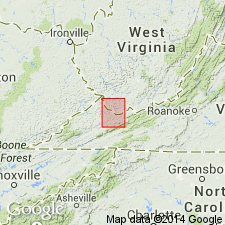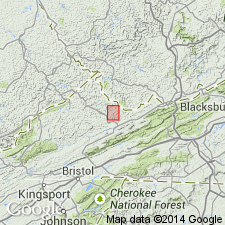
- Usage in publication:
-
- Dismal formation*
- Modifications:
-
- Original reference
- Dominant lithology:
-
- Sandstone
- Shale
- Coal
- Conglomerate
- AAPG geologic province:
-
- Appalachian basin
Summary:
Dismal formation. Shale and sandstone, with several important coal seams, and, in western part of quadrangle, a coarse conglomerate (Dismal conglomerate lentil, 0 to 120 feet thick), near middle. Thickness 490 feet. Overlies Raleigh sandstone and underlies Bearwallow conglomerate. Age is Pennsylvanian.
Both the formation and the conglomerate lentil named from exposures on Dismal Creek, Buchanan Co., southwestern VA. Extends into southern WV.
Source: US geologic names lexicon (USGS Bull. 896, p. 613).

- Usage in publication:
-
- Dismal Sandstone Member*
- Modifications:
-
- Revised
- Age modified
- AAPG geologic province:
-
- Appalachian basin
Summary:
Dismal Formation and its Dismal Conglomerate Lentil of Campbell (1897) are revised as Dismal Sandstone Member of New River Formation, one of its four named members. Overlies Council Sandstone Member; underlies McClure Sandstone Member. Age is refined to Early Pennsylvanian.
Source: GNU records (USGS DDS-6; Reston GNULEX).
For more information, please contact Nancy Stamm, Geologic Names Committee Secretary.
Asterisk (*) indicates published by U.S. Geological Survey authors.
"No current usage" (†) implies that a name has been abandoned or has fallen into disuse. Former usage and, if known, replacement name given in parentheses ( ).
Slash (/) indicates name conflicts with nomenclatural guidelines (CSN, 1933; ACSN, 1961, 1970; NACSN, 1983, 2005, 2021). May be explained within brackets ([ ]).

